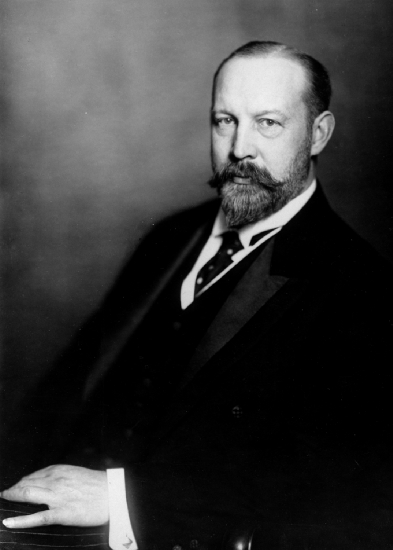The Foundation of The Deutsches Hygiene-Museum (1912)
Karl August Lingner (1861-1916)
Karl August Lingner (1861-1916), the Odol mouthwash
manufacturer, initiated the foundation of the Deutsches
Hygiene-Museum (1912). In 1911, Lingner was the driving
force behind the First International Hygiene Exhibition which
drew over 5 million visitors to Dresden. This exhibition
provided information not only about human anatomy but also
about health care, nutrition and living. The exhibition was
also so successful because the objects were presented with the
most modern technology in an unprecedented visually graphic
way. During the Weimar Republic years the museum contributed
decisively to the development of a more democratic public
health system through its comprehensible state-of-the-art
scientific presentations. (1912)
Brief Time line
1911
The First International Hygiene Exhibition is held in Dresden,
sponsored largely by the Dresden manufacturer Karl August
Lingner, the producer of Odol mouthwash. Lasting from May
through October, the exhibition is seen by a record
5 million people. Lingner develops the idea for a national
hygiene museum.
1912
This year marks the founding of The Apprentice Workshops of the
Deutsches Hygiene-Museum, GmbH. A permanent exhibition, "Man,"
is installed.
1919
Touring shows at home and abroad mark the commencement of the
museum's exhibition activities. Between 1919 and 1937, the
museum mounts 1,241 exhibitions, attracting 30 million
visitors throughout the world.
1920
The association created to promote the construction of a new
museum facility is renamed the Deutsches Hygiene-Museum
Association. Many important public figures, companies, and
organizations are members.
1927
After the cornerstone is laid near Dresden's city center,
construction begins on today's museum building, designed by
Professor Wilhelm Kreis. The production and international
distribution of instructional materials increases. By 1937, for
example, output included approximately 497,000 charts and
illustrations and 735,000 photographs about anatomy, health,
and hygiene.
1930
On May 16, the newly completed Deutsches Hygiene-Museum
opens. The main attraction of the subsequent Second
International Hygiene Exhibition is the "Transparent Man."
1933
Numerous exhibitions are mounted but are misused by the
National Socialists to propagate
their Nazi racial ideology after they take power.
1945
The museum building suffers severe structural damage in a bombing raid on the night of February 13. Valuable parts of the collection are destroyed. The Deutsches Hygiene-Museum is rebuilt immediately after the war ends and reopens on September 1 as the Institute for Hygienic and Medical Propaganda of the German Central Administration for Health in the Soviet Zone of Occupation.
1946
The production of models depicting human biological functions
is resumed.
1949
The first postwar exhibitions are organized: "Venereal Diseases
and Ways to Combat Them" and "National Diseases." The museum
resumes the activity of mounting exhibitions abroad. In
Stockholm, the "Transparent Woman" makes her first postwar
appearance.
1956
The "Transparent Horse" is developed. Artificial skeletons are
produced for the first time.
1967
The museum is renamed the "Deutsches Hygiene-Museum in the
G D R." The Institute for Health
Education and the Institute for Biological and Anatomical
Illustrative Material are founded.
1987
The Deutsches Hygiene-Museum is appointed to serve the World
Health Organization (WHO) as the Cooperation Center for Health
Education.
1990
The Free State of Saxony assumes responsibility for the museum
as a state institution administered by the Saxon State Ministry
for Social Affairs, Health, and Family. The manufacturing
workshops are privatized and converted into a company called
Instructional Materials, GmbH.
1991
The Health and Environment Forum and the Science Forum are
founded as departments. The concept of the Deutsches
Hygiene-Museum is expanded to include special exhibitions,
congresses, and conferences on the topics of man, body, health,
environment, and culture.
1992
A competition held by the Free State of Saxony to decide who
shall renovate the Deutsches Hygiene-Museum is won by the Coop
Himmelb(l)au Architectural Office in Vienna.
1996
The Deutsches Hygiene-Museum collaborates on the concept for
parts of the Man-Nature-Technology theme park of the world
exhibition, EXPO 2000, in Hanover, Germany.
1998
After a new selection process, the Dresden architect Peter
Kulka is entrusted with the renovation of the building housing
the Deutsches Hygiene-Museum.
1999
The Deutsches Hygiene-Museum Foundation is founded with the
participation of the Free State of Saxony, the capital city of
Saxony (Dresden), and the Deutsche Krankenversicherung
AG.
2001
General renovation of the Deutsches Hygiene-Museum begins.
2004
The first section of the new permanent exhibition opens on
April 1.
2005
The second section of the new permanent exhibition opens on April 23.
Source: Deutsches Hygiene-Museum

